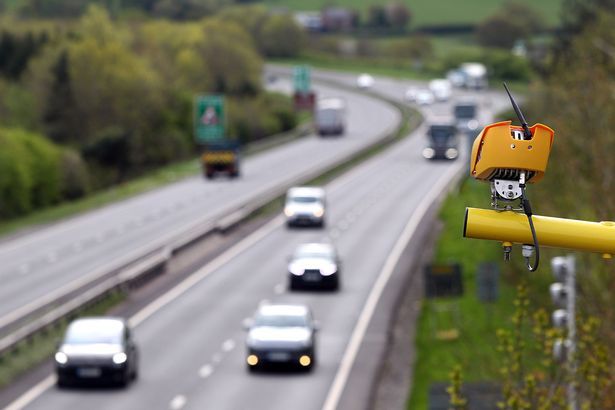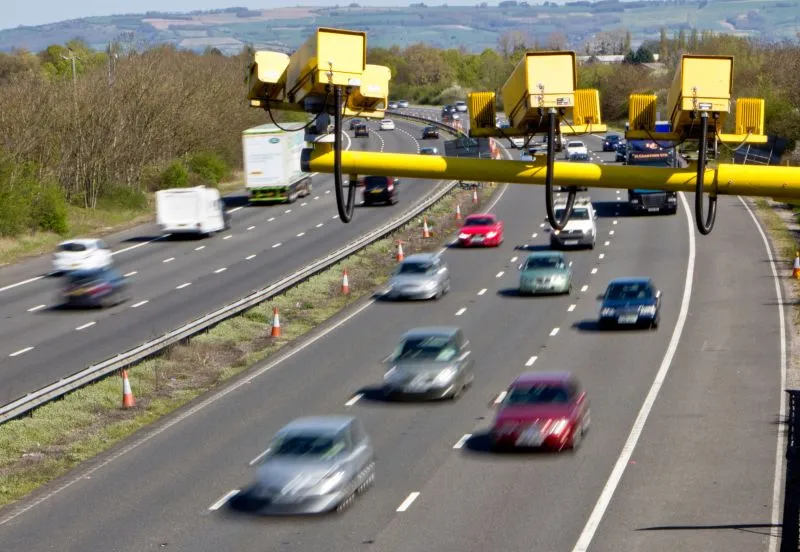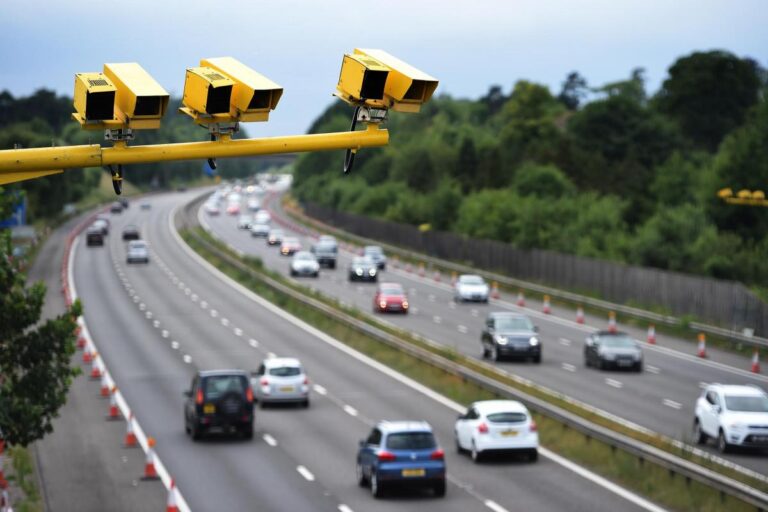The speed camera flashing twice when you weren’t speeding could be due to various reasons. Sometimes, these cameras may experience technical glitches or errors, leading to false readings. Weather conditions, such as heavy rain or bright sunlight, could also impact the camera’s accuracy.
Additionally, changes in speed limits or recent updates to the camera system might contribute to unexpected flashes. If you find yourself in this situation, it’s essential to consider these factors and, if necessary, contest the ticket.
How do speed cameras work to monitor road safety?

Speed cameras work by using advanced technology to monitor and regulate road safety. These devices typically utilize radar, laser, or both to measure the speed of vehicles passing through a specific area.
When a vehicle exceeds the preset speed limit, the camera captures an image or records a video, including the vehicle’s license plate. This information is then used to issue speeding tickets or warnings.
The goal is to encourage drivers to adhere to speed limits, promoting safer driving habits and reducing the risk of accidents. Speed cameras play a crucial role in enforcing traffic laws and contributing to overall road safety.
What are the Common Reasons for False Alarms?
Anomalies in Road Markings
Inconsistent or unclear road markings, temporary signs, or shadows can create optical illusions for speed cameras. These anomalies might be misinterpreted as sudden changes in vehicle speed, leading to false alarms.
Reflections from Nearby Objects:
Reflective surfaces from vehicles or structures close to the road may bounce back radar or laser signals, confusing the camera system. This reflection can be mistakenly identified as a speeding violation, triggering a false alarm.
Interference from Other Technologies
Electronic devices or infrastructure nearby, such as radio transmitters or power lines, can introduce interference. This interference may disrupt the accurate functioning of speed detection technology, resulting in false readings and alarms.
Inadequate Maintenance
Regular maintenance is crucial for speed camera reliability. If sensors are not calibrated correctly or software updates are neglected, the system may experience technical glitches, leading to false alarms. Proper maintenance helps ensure the accuracy of speed readings.
Environmental Conditions
Adverse weather conditions, such as heavy rain, snow, or intense sunlight, can impact the camera’s ability to capture clear images and accurately measure speeds. Weather-related distortions may lead to false alarms as the system struggles to interpret the data accurately.
What are the major technical elements in speed camera operation?
Radar or Laser Technology
Speed cameras use radar or laser technology to measure the speed of passing vehicles. Radar systems emit radio waves, while laser systems use light pulses.
These waves or pulses bounce off vehicles, and the speed camera calculates the speed based on the change in frequency or time it takes for the signal to return.
Triggering Mechanism
Speed cameras are equipped with a triggering mechanism that activates the camera when a vehicle exceeds a preset speed limit. This mechanism ensures that only speeding violations are captured, optimizing the camera’s efficiency.
Image Capture Systems
Cameras associated with speed detection capture images or record videos of vehicles violating speed limits. These images serve as evidence for law enforcement and may include details such as the vehicle’s license plate, date, and time of the violation.
Data Processing Unit
The data processing unit receives information from the radar or laser systems and analyzes it to determine if a speeding violation has occurred. It calculates the vehicle’s speed, checks it against the preset limit, and triggers the camera accordingly.
Communication Systems
Many modern speed cameras are equipped with communication systems that allow them to transmit data in real-time. This can include sending violation details to a central database or directly to law enforcement for further action.
Power Supply
Speed cameras require a stable power supply to operate consistently. They may be connected to the electrical grid or use alternative power sources such as solar panels or batteries, depending on their location.
Weather-Resistant Housing
Speed cameras are often housed in weather-resistant enclosures to protect the sensitive electronic components from environmental conditions. This ensures reliable operation regardless of weather variations.
How do regional policies impact speed camera usage in the UK?
Government’s Role
In the UK, speed cameras play a crucial role in the government’s plan to make roads safer. The government has a road safety strategy called “Tomorrow’s Roads: Safer for Everyone”, which has set targets to reduce road casualties by 2010. One of the main ways they plan to achieve this is by using speed cameras to enforce speed limits.
Safety Camera Partnerships
The Vehicles (Crime) Act 2001 has made it easier to use speed cameras. It allows Safety Camera Partnerships, which include the police, courts, local authorities, and highways authorities, to recover the costs of installing and operating cameras from the Treasury.
Process of Prosecution
Nowadays, most speeding offences in the UK are detected by either mobile or fixed speed cameras. All these cameras rely on some kind of photographic evidence to convict the offender.
Speed Limit Tolerance
In most parts of the UK, police forces allow a tolerance of 10% plus 2 mph above the speed limit before a speed camera activates. This means that on a road with a 30 mph speed limit, a camera wouldn’t usually activate unless a car drove past at 35 mph or faster. On a motorway with a 70 mph speed limit, the threshold would increase to 79 mph.
Local Deployment Criteria
It is suggested that local deployment criteria should be developed. This would mean that traffic authorities and road safety partnerships would have a systematic approach to choosing sites.
These points show how regional policies can affect the use and effectiveness of speed cameras in the UK. However, the specific policies can vary greatly between different regions and countries.
What steps can you take if wrongly accused by a speed camera?

Review the Evidence
Obtain and carefully review the evidence provided by the speed camera. Check the accuracy of the timestamp, location, and any captured images. Understanding the details of the alleged violation is crucial in assessing the validity of the accusation.
Check for Technical Issues
Investigate the possibility of technical issues with the speed camera. Look into potential malfunctions, calibration errors, or maintenance lapses that could lead to inaccurate readings. Understanding the technology behind speed cameras helps assess the reliability of the data.
Consult Local Traffic Laws
Familiarize yourself with local traffic laws and regulations related to speed camera usage. Ensure that the deployment of the camera complies with legal requirements. Understanding the legal context helps determine if there are grounds for contesting the accusation.
Gather Witness Statements
If there were witnesses to the incident, collect their statements. Witnesses, especially those who can attest to your adherence to the speed limit, can provide valuable support when disputing a speed camera violation.
Contact Local Authorities
Reach out to the local traffic authorities responsible for the speed camera program. Provide a clear and concise explanation of your situation, presenting any evidence or supporting documentation you have gathered. Seek clarification on the alleged violation and inquire about the procedures for contesting it.
File a Formal Complaint
If necessary, file a formal complaint with the appropriate traffic or legal authorities. Follow the designated process for contesting a speed camera ticket. Include all relevant details, evidence, and a clear statement outlining why you believe the accusation is incorrect.
Seek Legal Advice
Consult with a legal professional specializing in traffic law. They can provide expert advice on the specific regulations governing speed camera usage in your area and guide you through the process of disputing the accusation.
Attend a Hearing, if Required
If your case proceeds to a hearing, attend and present your case. Be prepared to articulate your argument, provide evidence, and respond to any questions. Adherence to the legal process increases the likelihood of a fair resolution.
FAQ
Do speed cameras flash even in the day?
Speed cameras can indeed flash during the day. The flashes emitted are designed to enhance visibility and capture clear images regardless of the time.
Do speed cameras flash forward?
Speed cameras generally flash from behind the vehicle. This positioning ensures a clear image of the vehicle’s license plate, aiding in accurate speed enforcement.
Do speed cameras flash twice?
Some speed cameras do flash twice when detecting a potential speeding violation. The double flash helps capture multiple images for precise speed measurement and documentation.
What does 1 flash on a speed camera mean?
A single flash from a speed camera typically indicates that it has recorded an event, commonly triggered by a vehicle exceeding the speed limit. This flash captures the necessary evidence for potential enforcement.
What color is the flash on a speed camera?
The flash on a speed camera is often white. White light provides optimal illumination for capturing clear images, ensuring accurate identification of the vehicle and its details.
How do I know if a speed camera flashed me?
If a speed camera flashes, you may notice a sudden bright light in your rearview mirror. Additionally, some cameras have an LED indicator that lights up when activated. However, it’s essential to check for official notifications or tickets for confirmation.
What happens if you slow down during a speed camera?
Slowing down during a speed camera is a proactive measure. If you bring your speed within the limit before passing the camera, you decrease the likelihood of triggering it. However, it’s crucial to always adhere to posted speed limits for overall road safety.
Final thoughts
If your speed camera flashes twice but you weren’t speeding, various factors may contribute to the unexpected alerts. Technical glitches, environmental conditions, or changes in speed limits could be at play.
It’s crucial to review the evidence, consider potential issues, and understand local regulations. If you believe you were wrongly accused, follow the steps to contest the violation. Staying informed about speed camera operations and regional policies is essential for navigating these situations.

